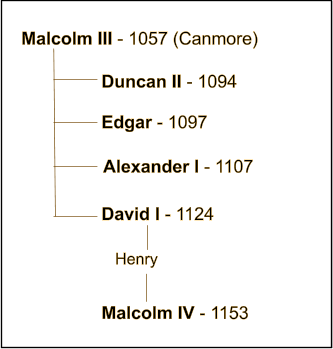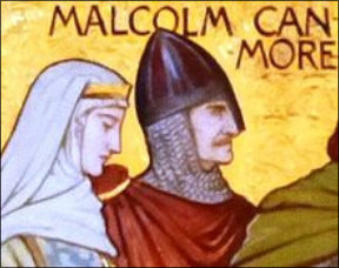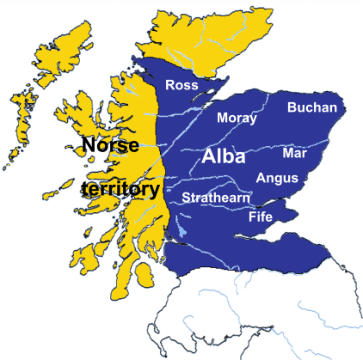
Gaelic Kings
At the time of Somerled’s birth, the Norse occupied the north and west of mainland Scotland and all the islands from Shetland through Orkney, Hebrides and south to the Isle of Mann. The remainder of the mainland, Alba, was ruled by one of the sons of Malcolm III (Somerled’s birth date is not known exactly), who were breaking away from Gaelic tradition and implementing feudal rule. Traditionally, each clan had its chief. Over the chiefs in each region was a minor King (Gaelic, Righ, also variously referred to in English as earl or mormaer). Over all was the High King (Ard Righ) who achieved the position as a result of election by the seven Righ (often abreviated to Ri). This process of election to leadership applied at all levels (clan, regional, national), but this was changed due to the demands of the Canmore kings. There’s more on the Tanistry page.The Change to Feudalism
From the time of Kenneth mac Alpin (843), the idea of a Scottish Nation was developing. At the same time, something similar was happening in what became known as England. With the arrival of William the Conqueror (1066) and the introduction of the feudal system, a new concept was brought to Britain: The king didn’t just rule all he surveyed… …he owned it! The kings of Scotland liked this idea and, particularly from Malcolm III onwards, progressively introduced feudalism. This meant that, on the principle of primogeniture, the crown automatically passed to the oldest son or closest relative in the Canmore family, disregarding the traditional system of Tanistry. Rebellion against this new process usually resulted in the rebellious mormaer being imprisoned or killed and replaced by a Norman noble invited from England, or continental Europe, to take up the land and position, thus further extending feudalism in the country. Other results of this process included the loss of land rights by the clans because the King (the new owner) had put a Norman in charge, and quite separately, the Celtic church was being replaced by buildings and clergy of the Roman church. King David I, the king of Scotland for most of Somerled’s life, had spent much of his early life in England and, despite his Gaelic ancestry, had become fully Normanised. This, and the need to restore order in Alba following years of strife over the succession, probably accounts for his determination to complete the process of changing Alba to a feudal society.Links with England
Any king of the time had to secure his kingdom. They usually adopted one or more of three basic approaches to achieving this. 1. A king could maintain an army, by whatever means, to protect his borders, as the English did for some time along the border with Wales. 2. A king could try to maintain friendly relationships with his neighbours (diplomacy). 3. A king might annex the neighbour and make it part of his kingdom. Actually, this third method was not always a solution. Sometimes, it just moved the border over a bit, giving the king a new neighbour to fight with. The Canmores invested heavily in option 2; marrying English or French noble women and marrying their female relatives to Norman/English nobles. King Henry I of England arranged for David (aged 29 and not yet king of Scotland), to marry Maud (also known as Matilda), Countess of Huntingdon, making David the Earl of Huntingdon. David’s sister (also a Matilda) was later married to Henry I. This is partly why, when Henry I died, David went to war on behalf of Henry’s daughter Matilda (yes, another one!), to put her on the English throne. Much of David’s early life was influenced by King Henry who was probably preparing for the day when he could make Scotland part of his kingdom. But it helped David because, when the opportunity arose for David to make a bid for the Scottish crown, it was a case of “my friends are bigger than your friends”! This building of relationships did not stop the fighting between the Scottish and English monarchies, but it did give them reasons to stop fighting now and then, and discuss possible peaceful solutions to the issues that had caused the fighting in the first place. The net result of the power struggles that were going on in Scotland during the 12 th century seems to be that, while Somerled was removing Norse power in the west, the Canmore kings were introducing Norman (descendants of the Norse) power in the rest of the country.




Gaelic Kings
At the time of Somerled’s birth, the Norse occupied the north and west of mainland Scotland and all the islands from Shetland through Orkney, Hebrides and south to the Isle of Mann. The remainder of the mainland, Alba, was ruled by one of the sons of Malcolm III (Somerled’s birth date is not known exactly), who were breaking away from Gaelic tradition and implementing feudal rule. Traditionally, each clan had its chief. Over the chiefs in each region was a minor King (Gaelic, Righ, also variously referred to in English as earl or mormaer). Over all was the High King (Ard Righ) who achieved the position as a result of election by the seven Righ (often abreviated to Ri). This process of election to leadership applied at all levels (clan, regional, national), but this was changed due to the demands of the Canmore kings. There’s more on the Tanistry page.The Change to Feudalism
From the time of Kenneth mac Alpin (843), the idea of a Scottish Nation was developing. At the same time, something similar was happening in what became known as England. With the arrival of William the Conqueror (1066) and the introduction of the feudal system, a new concept was brought to Britain: The king didn’t just rule all he surveyed… …he owned it! The kings of Scotland liked this idea and, particularly from Malcolm III onwards, progressively introduced feudalism. This meant that, on the principle of primogeniture, the crown automatically passed to the oldest son or closest relative in the Canmore family, disregarding the traditional system of Tanistry. Rebellion against this new process usually resulted in the rebellious mormaer being imprisoned or killed and replaced by a Norman noble invited from England, or continental Europe, to take up the land and position, thus further extending feudalism in the country. Other results of this process included the loss of land rights by the clans because the King (the new owner) had put a Norman in charge, and quite separately, the Celtic church was being replaced by buildings and clergy of the Roman church. King David I, the king of Scotland for most of Somerled’s life, had spent much of his early life in England and, despite his Gaelic ancestry, had become fully Normanised. This, and the need to restore order in Alba following years of strife over the succession, probably accounts for his determination to complete the process of changing Alba to a feudal society.Links with England
Any king of the time had to secure his kingdom. They usually adopted one or more of three basic approaches to achieving this. 1. A king could maintain an army, by whatever means, to protect his borders, as the English did for some time along the border with Wales. 2. A king could try to maintain friendly relationships with his neighbours (diplomacy). 3. A king might annex the neighbour and make it part of his kingdom. Actually, this third method was not always a solution. Sometimes, it just moved the border over a bit, giving the king a new neighbour to fight with. The Canmores invested heavily in option 2; marrying English or French noble women and marrying their female relatives to Norman/English nobles. King Henry I of England arranged for David (aged 29 and not yet king of Scotland), to marry Maud (also known as Matilda), Countess of Huntingdon, making David the Earl of Huntingdon. David’s sister (also a Matilda) was later married to Henry I. This is partly why, when Henry I died, David went to war on behalf of Henry’s daughter Matilda (yes, another one!), to put her on the English throne. Much of David’s early life was influenced by King Henry who was probably preparing for the day when he could make Scotland part of his kingdom. But it helped David because, when the opportunity arose for David to make a bid for the Scottish crown, it was a case of “my friends are bigger than your friends”! This building of relationships did not stop the fighting between the Scottish and English monarchies, but it did give them reasons to stop fighting now and then, and discuss possible peaceful solutions to the issues that had caused the fighting in the first place. The net result of the power struggles that were going on in Scotland during the 12 th century seems to be that, while Somerled was removing Norse power in the west, the Canmore kings were introducing Norman (descendants of the Norse) power in the rest of the country.





Walter Jardine
About A Wolf in His Belly
The Normans
Alba




















